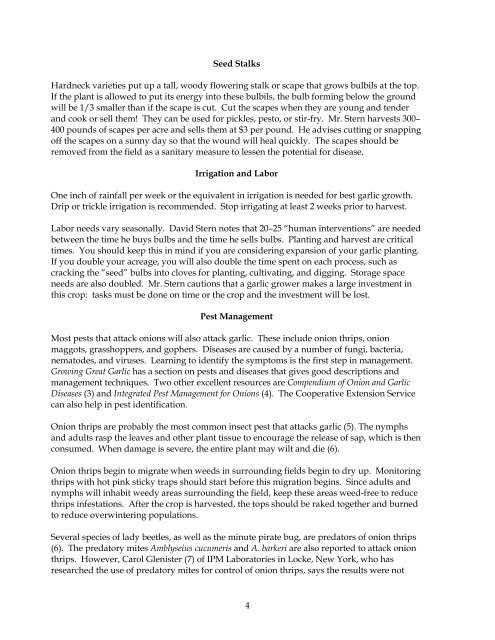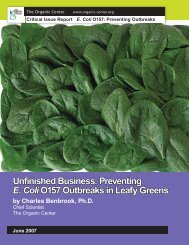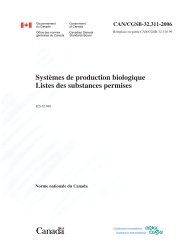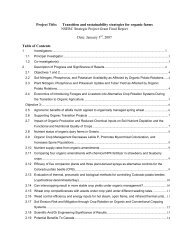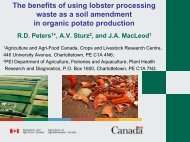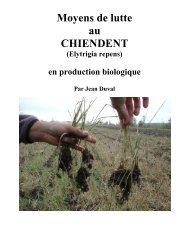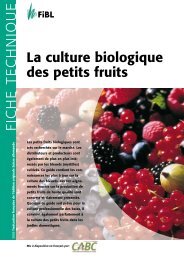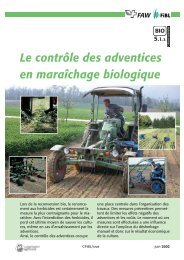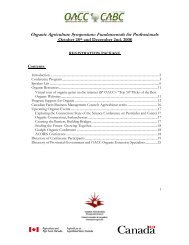Create successful ePaper yourself
Turn your PDF publications into a flip-book with our unique Google optimized e-Paper software.
Seed Stalks<br />
Hardneck varieties put up a tall, woody flowering stalk or scape that grows bulbils at the top.<br />
If the plant is allowed to put its energy into these bulbils, the bulb forming below the ground<br />
will be 1/3 smaller than if the scape is cut. Cut the scapes when they are young and tender<br />
and cook or sell them! They can be used for pickles, pesto, or stir-fry. Mr. Stern harvests 300–<br />
400 pounds of scapes per acre and sells them at $3 per pound. He advises cutting or snapping<br />
off the scapes on a sunny day so that the wound will heal quickly. The scapes should be<br />
removed from the field as a sanitary measure to lessen the potential for disease.<br />
Irrigation and Labor<br />
One inch of rainfall per week or the equivalent in irrigation is needed for best garlic growth.<br />
Drip or trickle irrigation is recommended. Stop irrigating at least 2 weeks prior to harvest.<br />
Labor needs vary seasonally. David Stern notes that 20–25 “human interventions” are needed<br />
between the time he buys bulbs and the time he sells bulbs. Planting and harvest are critical<br />
times. You should keep this in mind if you are considering expansion of your garlic planting.<br />
If you double your acreage, you will also double the time spent on each process, such as<br />
cracking the “seed” bulbs into cloves for planting, cultivating, and digging. Storage space<br />
needs are also doubled. Mr. Stern cautions that a garlic grower makes a large investment in<br />
this crop: tasks must be done on time or the crop and the investment will be lost.<br />
Pest Management<br />
Most pests that attack onions will also attack garlic. These include onion thrips, onion<br />
maggots, grasshoppers, and gophers. Diseases are caused by a number of fungi, bacteria,<br />
nematodes, and viruses. Learning to identify the symptoms is the first step in management.<br />
Growing Great <strong>Garlic</strong> has a section on pests and diseases that gives good descriptions and<br />
management techniques. Two other excellent resources are Compendium of Onion and <strong>Garlic</strong><br />
Diseases (3) and Integrated Pest Management for Onions (4). The Cooperative Extension Service<br />
can also help in pest identification.<br />
Onion thrips are probably the most common insect pest that attacks garlic (5). The nymphs<br />
and adults rasp the leaves and other plant tissue to encourage the release of sap, which is then<br />
consumed. When damage is severe, the entire plant may wilt and die (6).<br />
Onion thrips begin to migrate when weeds in surrounding fields begin to dry up. Monitoring<br />
thrips with hot pink sticky traps should start before this migration begins. Since adults and<br />
nymphs will inhabit weedy areas surrounding the field, keep these areas weed-free to reduce<br />
thrips infestations. After the crop is harvested, the tops should be raked together and burned<br />
to reduce overwintering populations.<br />
Several species of lady beetles, as well as the minute pirate bug, are predators of onion thrips<br />
(6). The predatory mites Amblyseius cucumeris and A. barkeri are also reported to attack onion<br />
thrips. However, Carol Glenister (7) of IPM Laboratories in Locke, New York, who has<br />
researched the use of predatory mites for control of onion thrips, says the results were not<br />
4


